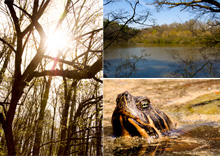Campus News
April 12, 2010
A vision for Emory forests

Preserving and managing Emory’s woodlands at heart of new plan
By Margie Fishman
In honor of Earth month, the University is unveiling a Forest Management Plan to guide the preservation and regeneration of its forested areas, with an emphasis on ecological connectivity, a healthy forest ecosystem and native biodiversity.
In a collaborative initiative of the University Senate Committee on the Environment (COE) and Campus Services, the umbrella plan incorporates other plans within its framework, including the Lullwater Comprehensive Management Plan, No-Net-Loss Policy for forest canopy and Land Use Classification Plan that sets aside more than 50 percent of campus as protected green space. The Forest Management Plan will serve as a visionary document for best practices in nurturing Emory’s forests, which are some of the best-preserved, hardwood forests in the entire Piedmont province of the Southeast.
Endorsed by the administration, the plan outlines a clear distinction between forest lands used for human activity and those to be left undisturbed. Among the plan’s goals are restoring the connectivity of Emory’s forests, particularly the natural corridor along South Peachtree Creek from Wesley Woods, through Harwood Forest and the Lullwater Preserve; developing a reforestation plan on campus; restoring and stabilizing stream banks; engaging in community outreach on the importance of forest ecosystems; and designating individual forest management plans for the University’s forest ecosystems, along with central campus areas, including Baker Woodlands and Tull Ravine.
The goals of the Forest Management Plan will be fulfilled within the context of available resources and other University priorities, and through grants and other funding opportunities pursued by the COE/Campus Services partnership.
“If you don’t start out with the right principles and goals, you’re bound to end up in the wrong place,” says John Wegner, senior lecturer in environmental studies, who was instrumental in drafting the plan along with COE chair Chris Beck and other members of the COE/Campus Services joint committee.
The plan is just the latest outgrowth of a productive collaboration between Wegner, representing the COE, and Bob Hascall, vice president for Campus Services. It was this spirit of cooperation, sprung from opposition to a proposed shuttle road skirting the edge of Lullwater more than a decade ago, that led to several milestones in Emory’s environmental policy.
In 1998, campus planners had proposed a quarter-mile road along the southern edge of Lullwater to transport people from the new Clairmont Campus parking deck to central campus. Commuters welcomed the road as an alternative to further congestion along North Decatur Road. Environmentalists foresaw the destruction of forest and streams, wildlife and rare vegetation, and a precious swath of solitude.
The shuttle road, Starvine Way, was completed in 1999 and restricted to alternative fuel vehicles, cyclists and pedestrians. Then-President William Chace immediately appointed a Lullwater Task Force to “oversee, manage and protect the land,” which led to the development of the Lullwater Comprehensive Management Plan, a guiding document to balance the land’s ecological health with human uses.
Hascall hired Wegner as an ecological consultant in his department. Wegner later became Emory’s first chief environmental officer, educating project managers on effective erosion control measures and drafting the University’s first vegetation map. He returned to teaching full-time last year.
The University affirmed its commitment to the environment in a mission statement approved by the University Senate in 2001, the same year the Board of Trustees, on Hascall’s recommendation, adopted a green building program. Today, Emory boasts one of the largest inventories by square footage of LEED-certified buildings among U.S. campuses, and operates the longest-running faculty development program in sustainability.
Following a 13-year tenure at Emory, Hascall will retire this summer before the Forest Management Plan is implemented.
“I don’t know if the shuttle road was a victory for anyone,” he says. “But it was the turning point for us to collaborate…I feel really good about where the organization is today.”
The remains of two white oaks from Lullwater occupy a place in Wegner’s office — and in his heart.
“Bob made all of this possible,” he says. “Otherwise, we’d all still be fighting.”
“A whole bunch of trees gave their lives to create something that would not have been created otherwise,” he continues. “When you look at the balance sheet, it clearly comes out on the positive.”
Quick Links
File Options
Related Information
The forest management plan is designed to “create, restore, enhance and maintain” Emory’s forested areas, emphasizing on ecological connectivity, ecosystem function and native biodiversity. Members of the Emory community are invited to join the effort.
